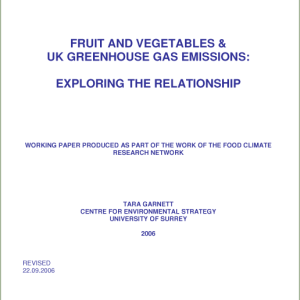
This paper considers what we know about the contribution that the fruit and vegetable sector makes to the UK's greenhouse gas emissions. It also looks at what we know about the options for achieving emissions reductions.
SUMMARY
1. Consumption of fruit and vegetables accounts for around 2.5% of the UK’s greenhouse gas emissions.
2. The trends suggest that consumer demand for the more greenhouse gas intensive fruits and vegetables is growing.
3. The most greenhouse gas intensive stages of the fruit and vegetable supply chain are transport and refrigeration. Waste is also highly significant since food that is produced but not eaten represents a waste of the energy used in its production, processing and distribution.
4. GHG intensive fruits and vegetables include:
- Air freighted produce: Typical examples include US berries and cherries, African green beans and peas, and pre-prepared salads produced outside Europe;
- Unseasonal Mediterranean style produce: Grown either in heated greenhouses in the UK or under protection (sometimes heated) overseas. Examples include tomatoes, courgettes, aubergines, peppers and salads;
- Pre-prepared, trimmed or chopped produce: Examples include salad bags and bowls, fruit salads and cut pineapple
- Fragile or highly perishable foods: These foods are prone to spoilage, which represents a waste of the energy embedded in their production, transport and storage
5. The least greenhouse gas intensive fruits and vegetables are seasonal field grown UK produce cultivated without additional heating or protection, which are not fragile or easily spoiled. Overseas grown produce which is reasonably robust, cultivated without heating or other protection and which is transported by sea or short distances by road are also fairly low in their greenhouse gas intensity. A GHG reduction strategy for fruit and vegetables is one which promotes the production and consumption of these kinds of foods.
6. Total self sufficiency (even if this were possible) is unlikely to be ‘the’ optimal answer since there are trade offs between import-related transport and mobile cold storage emissions on the one hand and waste and stationary cold storage emissions through the storage of indigenous food on the other.
7. Air freight is an area of particular concern. Around 1.5% of imported fruits and vegetables travel by air but this 1.5% accounts for around half of all emissions associated with fruit and vegetable transport, excluding travel to the shops. Including shopping trips, the air freighting stage accounts for two fifths of transport emissions.
8. Nothing is being done to tackle the problem of air freight and the sector is growing at 6% a year. If unchecked, air freighting of fruits and vegetables is set to grow. Little is being done to address transport emissions (and other environmental impacts) from roads and shipping even though here too trends suggest that imports are set to grow.
9. Refrigeration is another life cycle ‘hotspot.’ Key areas of concern include refrigeration in transit, excessive time spent in cold storage and in supermarkets. Food which is transported long distances or stored for long periods of time will be refrigerationintensive.
10. Wasted food represents a waste of the energy used and emissions produced during the course of growing, refrigerating and transporting food. Around 25% of all harvested fruits and vegetables are never consumed. Waste levels are highest in the home and in the food service sector. A reduction in food waste means a reduction in ‘unnecessary’ greenhouse gas emissions.
11. Improvements in energy efficiency at all stages in the supply chain are necessary. However action to address consumer behaviour is also vital both as regards people’s choice of certain products and their treatment of those products - how they travel to buy them, how they store and cook them, whether they waste them.
12. Consumers cannot voluntarily be expected to change their behaviours. The political, economic and social context in which they choose and consume food needs to change.
To read the full paper click here (PDF link).



Post a new comment »